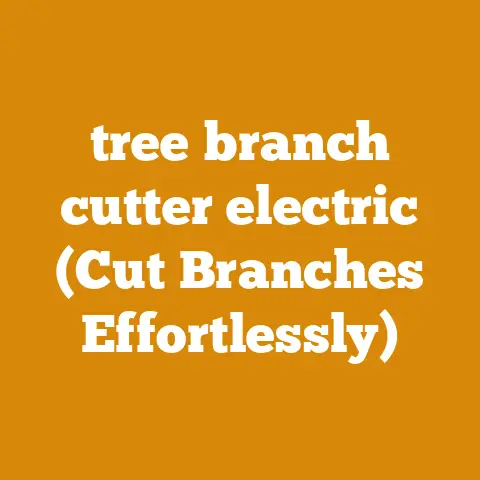Uprooted Stump Removal (5 Fast Methods) 26
Uprooted Stump Removal: 5 Fast Methods Explained
The Paradox of the Stump
You’d think removing a stump would be easier than taking down an entire tree, right? But here’s the kicker: sometimes, that stubborn stump is more challenging than the tree itself. I’ve been there, staring at what seems like a tiny problem but feels like a massive obstacle. Let’s talk about how to tackle this beast with some effective methods.
Personal Journey with Stumps
I remember when I first moved into my house; it had the most beautiful garden, except for one thing—a massive, obnoxious stump right in the middle. It was like having an uninvited guest at every backyard party. I tried different ways to get rid of it, and every attempt taught me something new. So, grab your gloves, and let’s get into it.
1. Chemical Removal: The Slow and Steady Tactic
Understanding the Method
Chemical stump removal is like setting a pot roast in a slow cooker. You know it’ll take time, but you’re confident that when you come back, the results will be worth it.
Materials Needed:
- Stump remover chemicals
- Drill with a large drill bit
- Wooden dowels (optional)
- Safety goggles and gloves
Step-by-Step Process:
- Drill Holes: Start by drilling holes into the stump. Aim for 8-12 inches deep and about 3-4 inches apart across the surface.
- Pour in Chemicals: Carefully pour the chemical stump remover into each hole. Some folks use wooden dowels to plug the holes to prevent rain from washing out the chemicals.
- Let it Sit: Patience is key here. The chemicals will slowly break down the wood fibers over weeks.
- Check Progress: After several weeks, test the stump’s softness by poking it with a shovel or axe handle.
- Remove the Stump: Once softened, dig out the remains or burn them if local ordinances permit.
Safety Tips:
- Always wear gloves and goggles when handling chemicals to protect your skin and eyes.
- Store chemicals safely away from children and pets.
My Experience:
Once, I used this method on a particularly stubborn pine stump. It sat there for what felt like an eternity, but when I finally dug it out, it was like scooping ice cream—soft and satisfying.
2. Burning Method: Playing with Fire (Safely)
Getting Fired Up
Burning a stump might sound a bit extreme, but done correctly, it’s an efficient way to turn that eyesore into ash.
Materials Needed:
- Kerosene or similar accelerant
- Metal barrel or old washing machine drum
- Matches or lighter
- Safety equipment
Steps to Ignite Success:
- Prepare the Stump: Drill holes into the stump for improved airflow and pour kerosene into them.
- Cover with Metal Drum: Place a metal barrel over the stump to contain the fire and improve airflow.
- Light It Up: Ignite from a safe distance using long matches or a stick lighter.
- Monitor: Keep a close eye on the fire to prevent it from spreading.
- Extinguish: Once reduced to ash, ensure all embers are fully extinguished.
Important Warnings:
- Check local regulations regarding open fires before starting.
- Have a hose or fire extinguisher handy just in case.
Lessons Learned:
I’ll never forget my first attempt at burning a stump. I didn’t use enough ventilation holes, so it smoldered rather than burned brightly. Lesson learned—airflow is everything!
3. Manual Digging: Old School Approach
The Backbreaking Truth
Manual digging is as old school as it gets, requiring nothing but muscle and perseverance.
Materials Needed:
- Shovel
- Mattock or pickaxe
- Chainsaw (if needed)
- Protective gear
Digging Deep Steps:
- Clear Surroundings: Remove any debris and soil around the base to expose roots.
- Cut Roots: Use a mattock or pickaxe to chop through larger roots obstructing your path.
- Loosen Soil: Dig around the perimeter of the stump, loosening soil as you go.
- Remove Stump: Rock the stump back and forth until it releases from the earth’s grip.
- Fill Hole: Refill the hole with soil or mulch to level your yard.
Cautionary Notes:
- Protect your back by lifting with your legs, not your back.
- Wear sturdy boots to safeguard your feet from sharp tools.
Real-Life Example:
The first time I tackled a stump manually, I underestimated its size. It took two days and some sore muscles, but when it finally came free, it was like winning a small victory.
4. Stump Grinder: Modern Efficiency
Power Meets Precision
A stump grinder is like having a grizzly bear on your side—powerful and efficient.
Materials Needed:
- Stump grinder rental
- Safety goggles and ear protection
Grinding Steps:
- Rent Equipment: Visit a local home improvement store to rent a stump grinder suitable for your needs.
- Position Grinder: Set up the grinder over the stump following manufacturer instructions.
- Operate Machine: Move the grinder back and forth over the stump until ground level.
- Dispose of Chips: Rake up wood chips for composting or mulch.
Safety Callout:
- Familiarize yourself with all controls before starting.
- Keep bystanders clear of the area during operation.
Field Experience:
Renting a grinder for the first time was intimidating, but once I got the hang of it, I realized it’s actually quite user-friendly and makes quick work of even large stumps.
5. Using a Winch: Mechanical Advantage
Harnessing Power
Using a winch involves mechanical leverage—perfect for tackling stubborn stumps without breaking too much sweat.
Materials Needed:
- Heavy-duty winch
- Chains
- Strong anchor point (another tree or vehicle)
Winching Steps:
- Secure Chains: Wrap chains securely around the base of the stump.
- Anchor Winch: Attach winch cable around a solid anchor point for stability.
- Pull Stump Out: Slowly winch until the stump uproots from its spot.
- Fill Hole: Refill any void left behind in your lawn.
Critical Warnings:
- Ensure all equipment is rated for expected loads.
- Stand clear of chains under tension—they can snap dangerously.
Tales from My Yard:
I once used a winch on a particularly stubborn cedar stump. Watching it pop out of the ground was incredibly satisfying—like pulling out a giant tooth!
Addressing Common Concerns
Can I combine methods?
Absolutely! Combining chemical treatments with grinding can be effective if you’re short on time.
What if my stump won’t budge?
Try reassessing your approach—sometimes switching tools or methods can make all the difference.
Which method is best for beginners?
Manual digging is straightforward but labor-intensive; chemical treatments are easier but slower.
FAQs Section
Is burning safe?
Only if carefully monitored with necessary precautions taken against potential fire hazards.
How long do chemicals take?
Typically 4–6 weeks; consult specific product instructions for detailed guidance.
Can equipment be rented?
Yes! Most hardware stores provide rentals for machines like grinders & winches if needed!
Ready to tackle that stubborn stump? Remember—I’m cheering you on every step of this journey!






